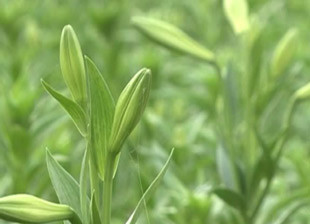Selecting and processing lily bulbs
The four-season lily is the result of the selection process of flower varieties with high economic value. The flowers are white, have a light fragrance, the flower shape is upward, the flower branches are hard, the growing period is 95-102 days. On average, a four-season lily plant produces 5-6 flower branches, compared to local lilies, the yield of four-season lilies is 2-3 times higher. To grow flowers effectively, the selection of varieties is very important, determining up to 70% of the flower quality.

Four Seasons Lily
The following are instructions from engineer Nguyen Van Quyet, North Central Institute of Agricultural Science and Technology, on how to select and process lily bulbs.
Planting season:
Four-season lilies have a growing period of 95-102 days. They can be planted many times a year: spring-summer (planted in February), autumn-winter (planted in August-October), winter-spring (planted in October-December).
Lilies have many ways to propagate such as by seeds, separating small bulbs, cuttings and separating buds. However, the method of propagating by separating small bulbs is the method that farmers often use. The advantage of this method is that the flowers have good vitality, can take advantage of bulbs from previous crops, especially saving planting time.
Cold treatment:
Before planting the bulbs 6-8 weeks, farmers need to cold treat the bulbs at a temperature of 2-5 degrees Celsius. The purpose of this cold treatment is to break the dormant buds of the bulbs and stimulate flower buds to develop.
Select seed tubers:
Farmers should choose bulbs with a diameter of 10 cm or more, without scratches. With bulbs that are too small, with a diameter of less than 10 cm, farmers should remove them. Because these bulbs will produce a small number of flowers on the tree, small flowers. Normally, the quality of flowers depends on the quality of the bulbs, the larger the bulbs, the better the quality of the flowers, the more flowers and vice versa, small bulbs will produce few flowers and small flowers.
Seed tuber classification:
Farmers need to classify bulbs according to different sizes to create uniformity, convenience for care and classification of flower quality later.
Farmers base on the largest circumference measurement of the tuber to classify, specifically divided into tubers of 10-12cm, 13-14cm, 15-16cm, 17-18cm, 19-20cm and circumference larger than 20cm.
Sterilizing seeds:
After classifying the seed tubers, farmers need to disinfect the seed tubers. The purpose is to destroy pathogens existing in the seed tubers, prevent harmful microorganisms from entering the seed tubers through scratches, contributing to increasing the survival rate of plants up to 70%.
Mix the fungicide solution (Rizomil, Topsin, Daconil) with a concentration of 0.1-0.2%, that is, for every 10-20 grams of fungicide, mix it with 10 liters of clean water. Submerge the entire seed tubers in the solution. When soaking, be careful not to stir the seed tubers.
After soaking the seeds for 10-15 minutes, remove the seeds, drain and plant.
Treatment of lily bulbs with fungicides contributes to increasing the survival rate of plants up to 70%.
According to VTC16.vn - LY






